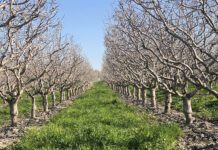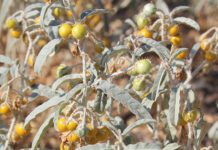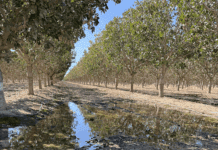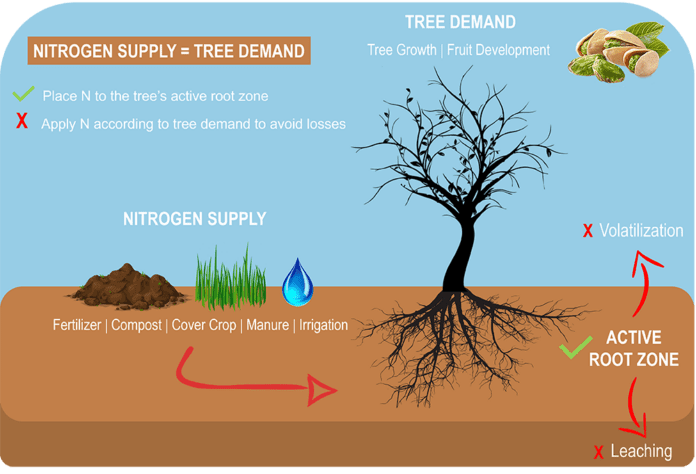
Nitrogen is the most important mineral nutrient in tree nut crop production. It can be absorbed as nitrate or ammonium by active roots. The key to sustainable pistachio N fertility is matching the amount and timing of N delivery to tree N use as excess N in the soil is easily lost from the root zone. If the N is not available in key application windows, yield can be lost. Therefore, spring and summer are key times for pistachio N management.
Matching Nitrogen Supply with Tree Demand
To reduce costs, maximize yield and minimize losses to the environment, matching tree N demand with N supply is essential. Therefore, when making fertilization decisions, growers need to consider the different supplies of N as well as the demand for N due to tree growth and fruit production requirements. An understanding of all different N (re)sources (fertilizer, compost, cover crop, manure, irrigation water) and how N can be “lost” (run-off, leaching, etc.) in the orchard will help growers better make management decisions.
As previously stated, N is essential for a wide range of processes in tree production, such as growth of all annual (flowers, leaves and kernel) and perennial organs (branches, trunk and roots). However, the primary factor impacting N demand in pistachio trees 10 years and older is fruit yield. The industry’s understanding of the pattern and rate of N uptake from the soil is derived from a series of experiments conducted in high-yielding orchards throughout California from 2008-11. Based on these trials, it is estimated with every 1,000 lbs. pistachio fruits produced (CPC yield), 28 lbs. N are exported from the field, and an additional amount of N is required to satisfy the trees’ annual growth demand (25 lbs. N per acre per year). Thus, potential yield estimation early in the season can have a significant impact on N management decisions.
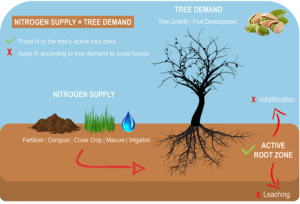
Approaches to Improve Nitrogen Management
To achieve maximum productivity and to reduce N losses to the environment, close attention to the 4Rs (Right Rate, Right Time, Right Place and Right (re)Sources) is needed in all orchard fertility programs. Another way to think of it is that you need to TRAP the N in the soil:
- Time N application according to tree uptake patterns
- Identify/understand available N resources (fertilizers, composts, manure, cover crops, irrigation water)
- Apply the amount needed according to tree demand
- Place N to the tree’s active root zone
Following the 4Rs principle can be viewed as a balancing act with the goal of applying adequate N to supply tree demand for growth and fruit production.
Fertilizer applications can be optimized, and considerable N losses can be reduced if N applications are matched with the actual tree N requirement. Ideally, N fertilizers should be applied at a rate and timing that are synchronized with the demand curve by using very frequent or even continuous fertigation as illustrated in Figure 2.
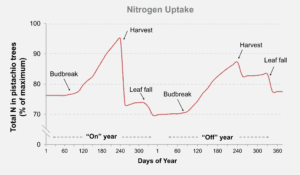
In the period from dormancy through early leaf-out, the tree depends almost fully on N that is remobilized from perennial organs, and practically no N uptake occurs from the soil. After flowering, during the period of leaf and fruit expansion, uptake from the soil starts while remobilization of N from perennial tissues continues. From full leaf expansion until early hull split, tree N demand is satisfied completely by soil N uptake. Following fruit maturity (hull split), tree N demand and root uptake decline quickly and stop completely as soon as leaves begin senescence. While fruit is developing, the rate of soil N uptake is directly determined by the yield of the tree. Even though the demand for N to support new tree growth is smaller than the demand for fruit development, the fertilization program should not only replace the nutrients removed in the fruits but also supply the nutrients for annual growth of the trees. N in flowers, leaves and perennial storage N is predominantly provided from internal and soil N recycling and, consequently, does not contribute to annual fertilizer N demand.
It is important to note all fertilization decisions will be influenced by local environment and must be adjusted accordingly. For example, in regions with rainfall that may persist well into leaf-out, application to the soil may be problematic. Also, in areas with substantial rainfall, growers must adopt practices that minimize the amount of N that resides in the soil at that time. Pre-harvest and postharvest foliar applications of N, as a substitute for soil applications, could be used to provide N to trees if yield and tissue sampling indicates a need.
Spring Leaf Sampling: Useful Tree Status Monitoring Tool
Determination of N concentration in leaves from the current season growth can also be useful in estimating tree N status, and annual leaf testing is recommended. This is an important tool to measure the adequacy of the fertilization program and to diagnose nutrient deficiencies and toxicities. However, the current practice of sampling leaves in July is too late to allow for current-season adjustment of fertilization practice. As a result, a validated model for predicting July N levels from tissue samples taken earlier in the season has been developed and can effectively predict summer tissue values. For example, a 3% N tissue analysis 40 days after full bloom would predict that you would have 2.6% in July, a level sufficient to begin kernel filling. The model allows growers to assess the future N status of their orchards from late April and May tissue samples and can be found at fruitsandnuts.ucdavis.edu/files/208409.xls.
Recommended Sampling Criteria
Leaf sampling is valuable and provides information on the status of the tree and the effectiveness of growers’ management decisions. Sampling can be conducted in mid-May to help predict seasonal N demand, while July sampling can be used to monitor plant N status and make end-of-year adjustments.
For each orchard/block or sub-block that you wish to have individual information on, do the following:
- Collect sub-terminal leaves from non-fruiting branches.
- Collect leaves from 18 to 20 trees per orchard.
- In each tree, collect 10 leaves around the canopy from well-exposed branches located between 5 to 7 feet from the ground.
- Combine all leaves in a single bag for submission to a reputable laboratory. Each sampled tree must be at least 25 to 30 yards apart. A minimum of 180 leaves per sample bag is required.
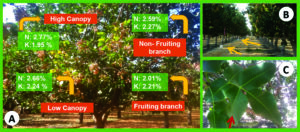
Nitrogen Management Plan
It is important to note leaf sampling alone does not provide sufficient information to make fertilizer recommendations. The recommended approach to N fertilization scheduling consists of the following steps and should be repeated for each orchard block:
- Conduct a pre-season estimate of expected yield, based on historic yield trends for each orchard, last year’s yield, winter chilling and spring flowering weather. Grower judgement and observation remain critical.
- Estimate annual inputs of N in irrigation water, manures, composts, fertilizers, etc.
- Calculate preliminary fertilization rates and timings and make first application of fertilizer in early to mid-spring (mid-May).
- Collect and analyze May leaf samples according to preceding instructions.
- Conduct in-season yield estimation (April to May).
- Adjust fertilization strategy for the remainder of year to reflect May leaf and yield estimates.
Too Much of a Good Thing
While it is always important to ensure sufficient N supply for optimum growth and yield, it is equally important we do not assume more is better. N is the nutrient most often abused in terms of this ‘more-on’ approach. Adding high levels of N to the soil early in the season will not result in greater plant uptake unless the tree is deficient. In addition, excess N can cause several problems; when N is overapplied, it negatively affects the uptake of other nutrients and can also cause excessive growth rather than production.
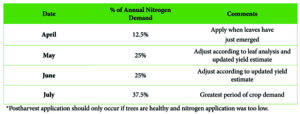
N management plays an important role in determining your bottom line so ensure you manage this nutrient well to keep tree performance, production and fruit quality up as well as costs down. Some approaches that can be adopted to minimize risks and optimize N use include applying N to meet tree demand according to tree uptake patterns. For this, an efficient irrigation system is essential; fertilizers must be present in the root system where they are most likely to be used by the tree.

In summary, an efficient management of N requires that every orchard that differs in age, soil, environment or productivity should be sampled and managed independently. Every individual orchard must have a specific N management plan; there is no “one-size-fits-all” approach.







